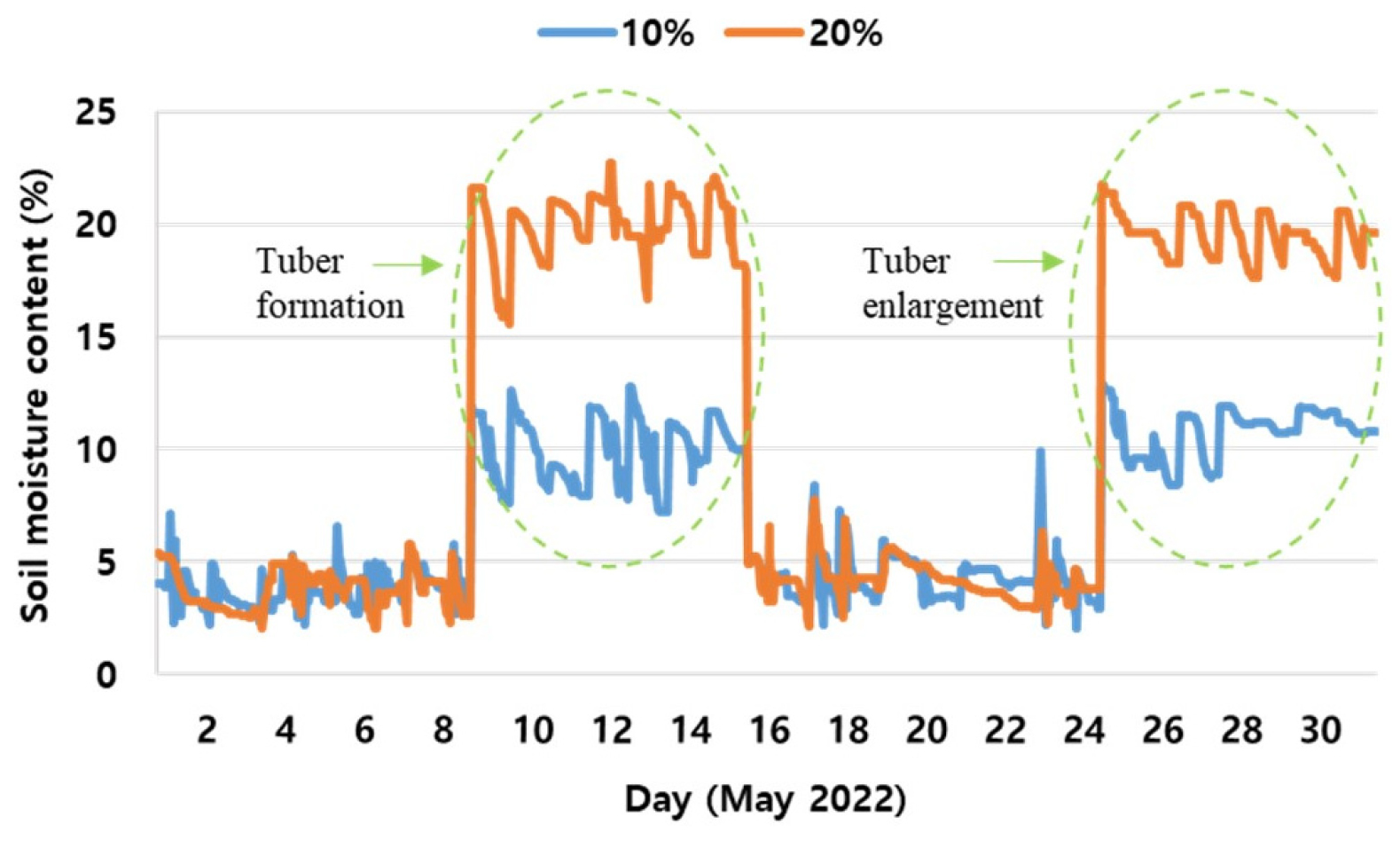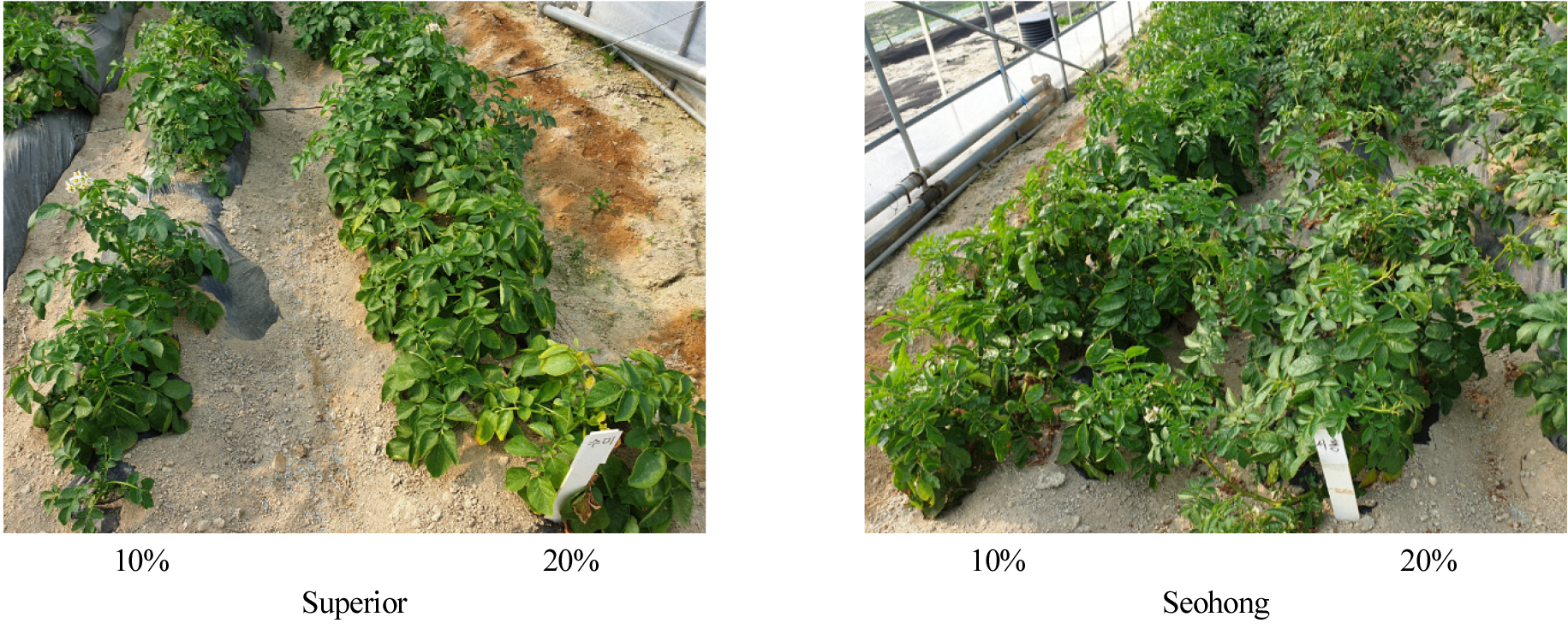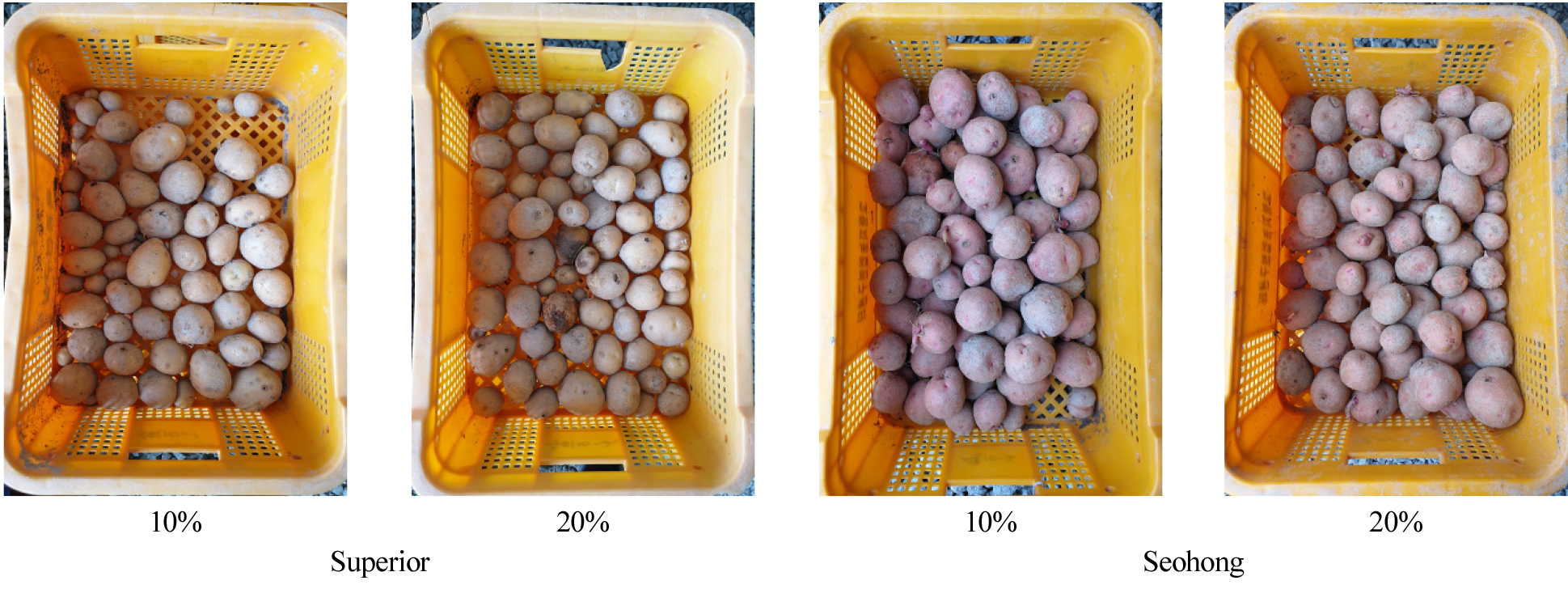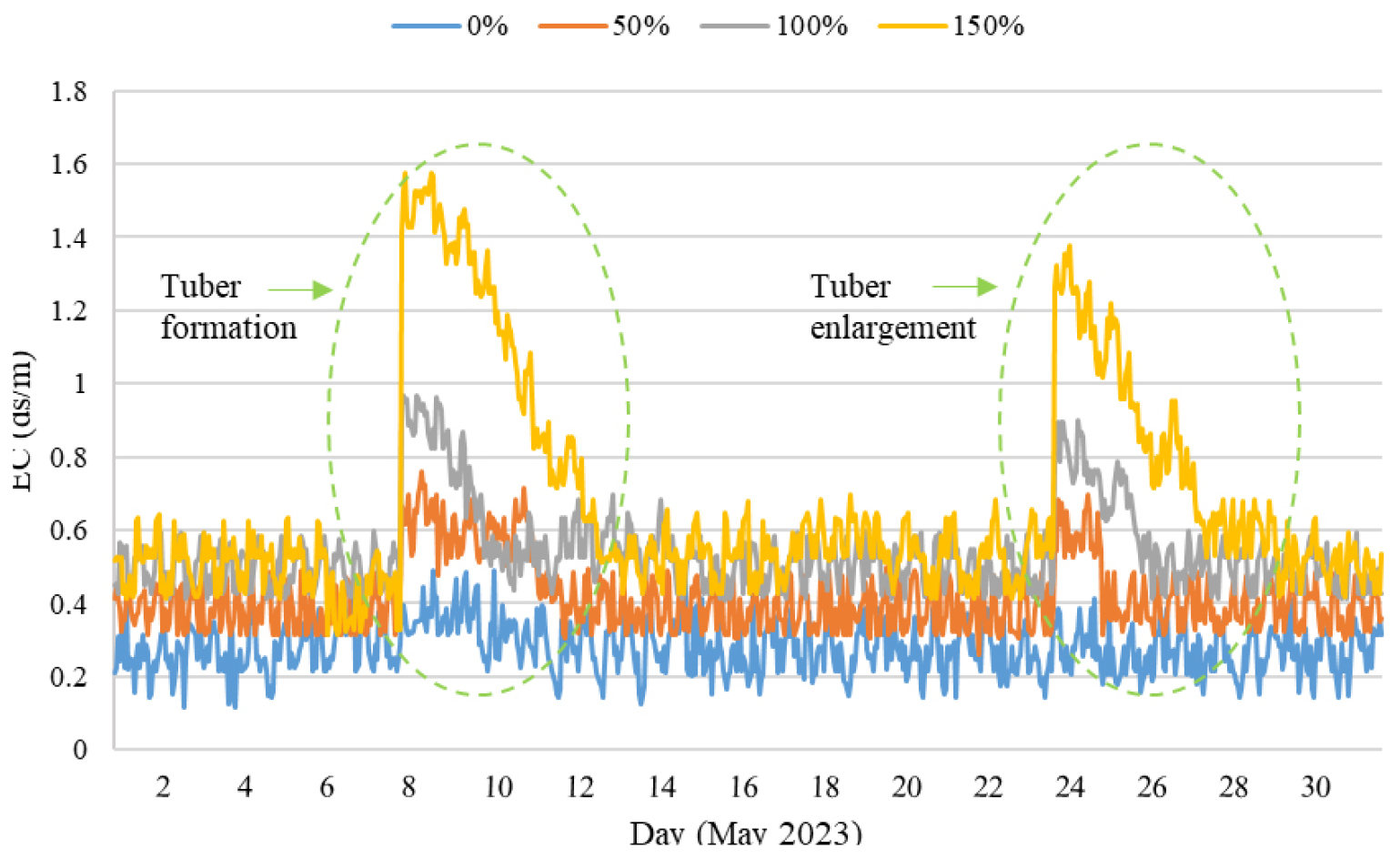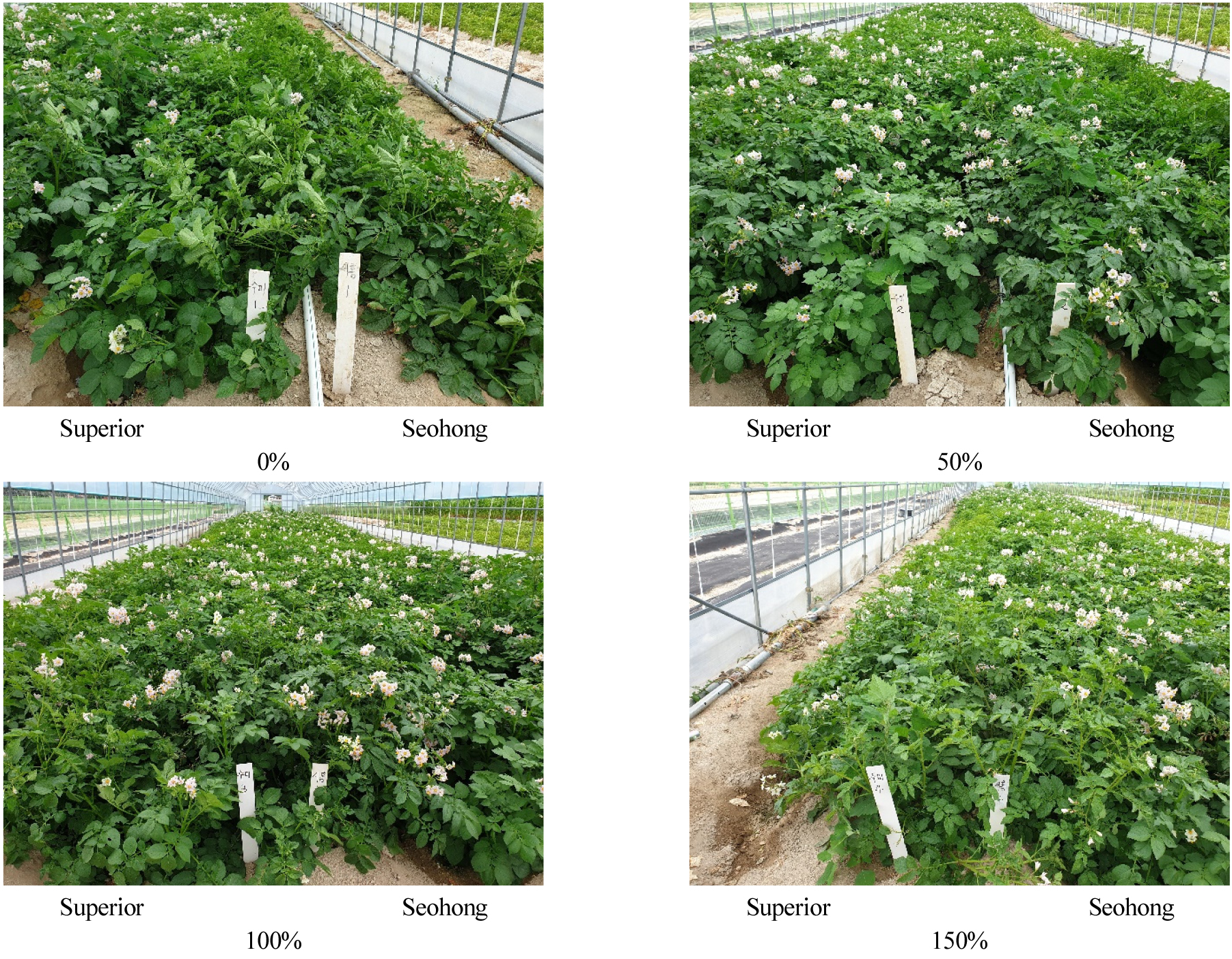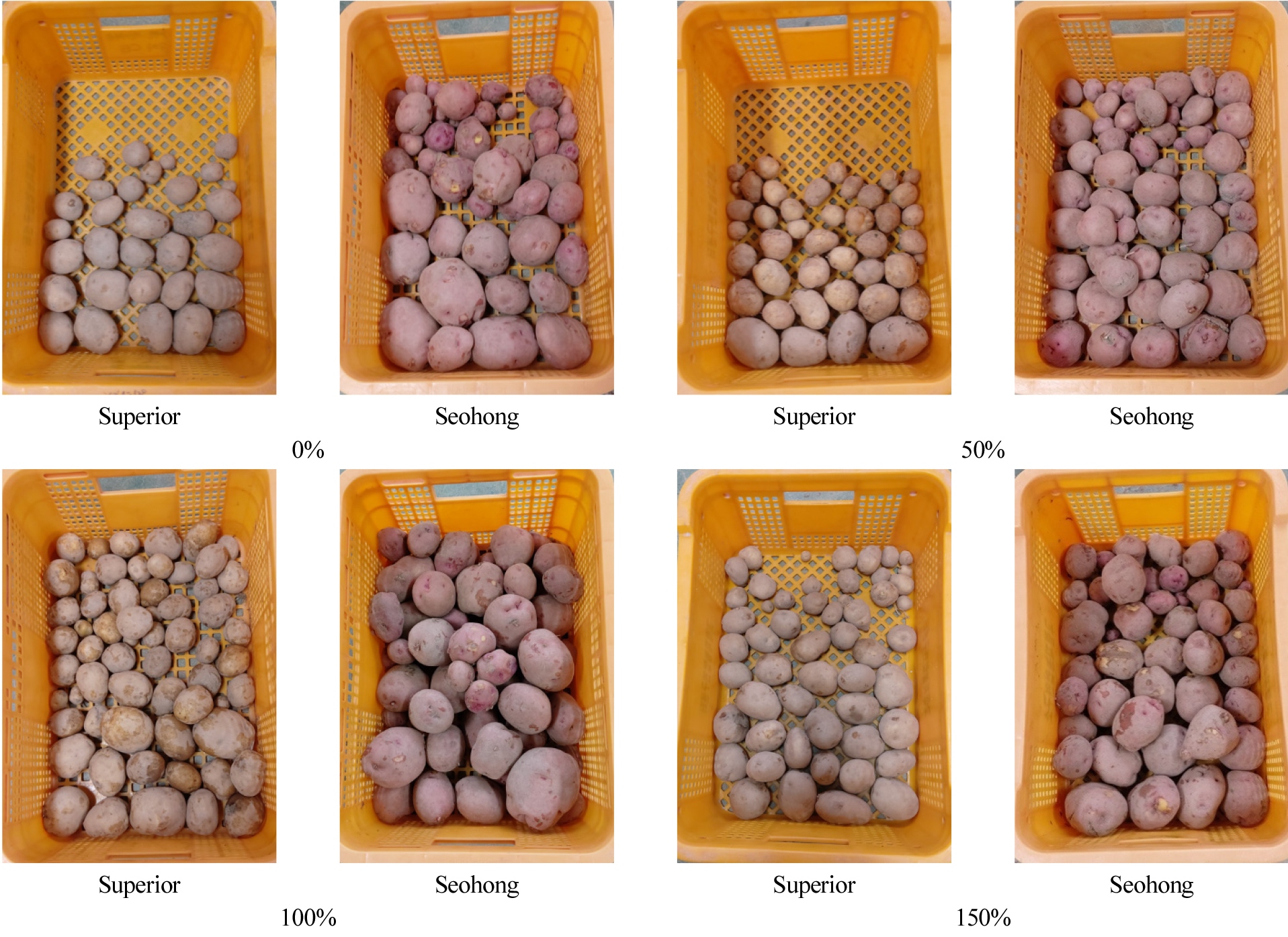Introduction
Materials and Methods
Test cultivars and cultivation conditions
Irrigation and fertilization treatment
Growth investigation
Yield determination
Soil moisture and Electrical Conductivity (EC)
Statistical analysis
Results and Discussion
Growth and yield of potatoes according to irrigation treatment
Growth and yield of potatoes according to fertigation treatment
Introduction
Potato (Solanum tuberosum L.), a member of the Solanaceae family, is believed to have originated from Peru and Bolivia in the Andes Mountains of South America. Potatoes are cultivated in over 150 countries worldwide and are the fourth most widely grown food crop, with annual production exceeding 350 million tons since 2010 (FAO, 2021). As of 2022, the potato cultivation area in Korea is approximately 21,000 hectares, yielding 480,000 tons (KOSIS, 2023). In Korea, potatoes are primarily used for starch, processing chips, French fries, snacks, and as raw materials for cosmetics and biodegradable products (Kwon et al., 2014; Lee et al., 2024).
Moisture and nutrient management during the tuber formation and growth stages significantly impact potato yields (Park et al., 2001; RDA, 2020). The increasing frequency of droughts due to climate change is expected to reduce crop yields by 2-26% for potatoes and by 35-61% for rice and soybeans (Jeong et al., 2020). In Korea, severe drought years see concentrated summer precipitation, making natural rainfall insufficient in other seasons. Therefore, artificial irrigation is necessary, particularly since potato cultivation mainly occurs in spring and fall (Kim et al., 2017). While most farms rely on natural rainfall, some enhance potato growth and yield through furrow irrigation, fountain hoses, sprinklers, and drip hoses. However, there is limited research on the effects of irrigation amount and period on potato growth and yield.
Fertilization also plays a crucial role in potato growth. The standard fertilizer amounts for spring potato cultivation are 12 ㎏ of nitrogen, 8.8 ㎏ of phosphoric acid, and 13 ㎏ of potassium, typically applied as base fertilizer. However, farmers often apply more than the recommended amounts (RDA, 2020). Fertilizer efficiency for crop production is generally 33% for nitrogen, 10-15% for phosphoric acid, and 19% for potassium, with the remainder lost through runoff, leaching, and volatilization (Dhillon et al., 2019). Fertilizer loss from agricultural lands is a non-point source of pollution, leading to issues such as eutrophication of rivers and groundwater contamination, prompting various studies to address these problems (Hartz and Hochmuth, 1996).
Fertigation, a cultivation method that dissolves water-soluble fertilizer in water and applies it through drip irrigation (Kim, 1970), can reduce fertilizer consumption due to higher crop absorption rates compared to conventional fertilization (Li et al., 2004). This method, initially used in the cultivation of peppers, paprika, and zucchini, is now also applied to field crops such as onions and garlic (Choi et al., 2017). Open-field fertigation has been reported to reduce fertilizer usage by 40-80% and increase yields by 22% in various crops, including potatoes (Salvador and Banoc, 2020). However, there is still insufficient research on the optimal amount of fertigation for potato cultivation in Korea.
This study aims to determine the optimal moisture content for spring potato cultivation and establish suitable standards for fertigation.
Materials and Methods
Test cultivars and cultivation conditions
This experiment was conducted over two years (2022-2023) in a rain-protected test field (7 m × 80 m) at the Highland Agriculture Research Institute, Sacheonjinri, Gangneung-si, Gangwon State. The test cultivars used were ‘Superior’ (Rieman, 1962) and ‘Seohong’ (Park et al., 2007), with their unique characteristics detailed in Table 1. Before planting, 1.5 tons of livestock manure compost (Seung Green Tec Co., LTD, Miryang-si, Korea), urea (Namhae Co., Yeosu, Korea), fused phosphate (Pungnong, Seoul, Korea), and potassium chloride (Namhae Co., Yeosu, Korea) were used as base fertilizers. After applying half the standard fertilizer amount (N-P2O5-K2O: 5-4.4-6.5 ㎏·10a-1), a single cultivation row was created. A drip hose (20 drip-tape, Okto, Seoul, Korea) was then installed and covered with black mulching vinyl (0.03 ㎜ × 95 ㎝ × 500m).
Table 1.
General characteristics of ‘Superior’ and ‘Seohong’ cultivars used in moisture and nutrient tests.
The irrigation test was sown on March 22, 2022 (spacing: 25 ㎝ between plants and 80 ㎝ between rows) and harvested on June 28. The fertigation test was sown on March 21, 2023, and harvested on June 26. Pest control, including measures against late blight, was conducted according to the Rural Development Administration’s standard farming textbook (Choi and Jung, 2017; RDA, 2018). The soil’s texture and physicochemical properties are detailed in Table 2, showing measurements from 2022 and 2023. Soil electrical conductivity was 0.35 and 0.21 dS·m-1, organic matter content was 16.8 and 19.0 g·㎏-1, and available phosphoric acid was 408 and 344 ㎎·㎏-1, respectively.
Table 2.
Soil texture and chemical characteristics before cultivation tests (2022-2023).
| Year | Soil texture |
pH (1:5) |
EC (ds·m-1) |
O.M (g·㎏-1) |
P2O5 (㎎·㎏-1) | K | Ca | Mg | Na |
| (cmol·㎏-1) | |||||||||
| 2022 | Sandy loam soil | 6.73 | 0.3 | 16.8 | 408 | 0.5 | 3.8 | 1.6 | 0.3 |
| 2023 | 7.06 | 0.2 | 19.0 | 344 | 0.4 | 3.6 | 1.2 | 0.1 | |
Irrigation and fertilization treatment
For irrigation treatment, the entire fertilizer amount was applied based on the Rural Development Administration’s potato standard fertilizer rate (N-P2O5-K2O: 10-8.8-13 ㎏·10a-1) before sowing. A sensor was buried 20 ㎝ into the soil using an automatic irrigation device (J.EZ-010E, JnP SYSTEM, Korea), ensuring the soil moisture content remained at 10% and 20%. Irrigation occurred twice for seven days each during the tuber formation and enlargement periods (Fig. 1).
Fertilization treatment followed the standard fertilization rate for potatoes (N-P2O5-K2O: 10-8.8-13 ㎏·10a-1), applying half the standard rate initially (N-P2O5-K2O: 5-4.4-6.5 ㎏·10a-1), with the remaining half applied as additional fertilization. This was done twice at seven-day intervals starting from the 50th day after sowing, covering the tuber formation and enlargement periods (Fig. 4). Three additional fertilization treatments 0.5 times (NPK 0.5, N-P2O5-K2O: 2.5-2.2-3.25 ㎏·10a-1), 1.0 times (NPK 1.0, N-P2O5-K2O: 5-4.4-6.5 ㎏·10a-1), and 1.5 times (NPK 1.5, N-P2O5-K2O: 7.5-6.6-9.75 ㎏·10a-1) the standard rate were applied. In the no-fertilization group, only basal fertilization was applied. Each fertilizer was diluted 400 times and irrigated through a liquid fertilizer mixer (PBI-D802MA/P 28 m3/h, WILO, Korea), with 500 mL applied per plant.
Growth investigation
Growth measurements were taken on May 20, 2022, and May 19, 2023, including stem length (㎝), stem number (no·plant-1), root length (㎝), stolon length (㎝), above-ground fresh weight (g), and above-ground dry weight (g), following the Rural Development Administration’s research standards (RDA, 2016). Stem length was measured from the ground to the uppermost node at 60 days after sowing, and stem number was counted at harvest. Root and stolon lengths were measured from the longest root and stolon, respectively. Above-ground fresh weight was measured with a laboratory electronic scale (AX2202KR/E, OHAUS Corp., USA), and dry weight was measured after drying in an oven (Dasol Science, DS-80, Korea) at 80°C for three days.
Yield determination
To determine yield, total yield (t·㏊-1), marketable yield (t·㏊-1), and tuber quantity distribution rate (%) were assessed. Total yield per area was calculated using the number of tubers produced per plant, and marketable yield included healthy tubers weighing 80 g or more. Tuber quantity distribution was classified into five categories (< 30 g, 31-80 g, 81-150 g, 151-250 g, and >251 g), with the ratio calculated accordingly.
Soil moisture and Electrical Conductivity (EC)
Soil moisture treatment was measured and controlled for seven days from May 9-15 and May 25-31, 2022, using a buried moisture sensor (J.EZ-010E, JnP SYSTEM, Korea). Data were collected using a data logger (WatchDog 1650, Spectrum Technologies Inc., Chicago, USA). For accurate fertilization data, a sensor (WatchDog SMEC 300, Spectrum Technologies Inc., Chicago, USA) was buried 20 ㎝ underground, and soil moisture content and electrical conductivity (EC) were measured using a data logger (WatchDog 1650, Spectrum Technologies Inc., Chicago, USA).
Statistical analysis
All treatments in this study were repeated three times and included two cultivars. Statistical analysis was performed using SPSS v25 (Statistical Package for Social Sciences, IBM, USA). Significance between treatment groups was evaluated using two-way analysis of variance (P < 0.05).
Results and Discussion
Growth and yield of potatoes according to irrigation treatment
To determine the optimal irrigation amount, soil moisture levels during the tuber formation and enlargement stages were set at 10% and 20%, respectively. The changes in soil moisture content by treatment are illustrated in Fig. 1. The moisture levels were based on the optimal soil moisture content for potatoes, typically reported as -25 ㎪ (18.5%) (King et al., 2020).
The growth characteristics of potato plants, including stem length, stem number, root length, stolon length, fresh weight of the above-ground part, and dry matter, were examined after treatment with different soil moisture contents. The results are presented in Table 3 and Fig. 2. Significant differences were observed between the ‘Superior’ and ‘Seohong’ cultivars. The ‘Seohong’ cultivar outperformed the ‘Superior’ cultivar in terms of stem length, root length, stolon length, above-ground fresh weight, and dry matter, except for stem number. Differences between treatments were notable in the fresh weight and dry matter of both the above-ground parts and tubers. Stem length and above-ground weight were significantly higher for both cultivars under the 20% soil moisture treatment. While stem number, root length, and stolon length did not show statistical significance, they were higher in the 20% treatment compared to the 10% treatment.
Table 3.
Growth characteristics of potato stem length, stem number, root length, stolon length, shoot fresh weight, and shoot dry weight according to soil moisture content treatment for two potato cultivars in 2022.
| Cultivar |
Soil moisture content |
Stem length (㎝) |
Stem number (no.·plant-1) |
Root length (㎝) |
Stolon length (㎝) | Shoot weight (g) | |
| Fresh | Dry | ||||||
| Superior | 10% | 31.1 | 5.7 | 8.2 | 15.9 | 234.0 | 68.3 |
| 20% | 38.2 | 6.0 | 8.3 | 21.2 | 443.7 | 94.0 | |
| mean | 34.7 | 5.9 | 8.3 | 18.6 | 338.9 | 81.2 | |
| Seohong | 10% | 61.3 | 3.7 | 15.2 | 23.1 | 756.3 | 130.3 |
| 20% | 89.3 | 4.0 | 17.7 | 27.1 | 1252.0 | 184.0 | |
| mean | 75.3 | 3.9 | 16.5 | 25.1 | 1004.2 | 157.2 | |
| Cultivar (C) | ***z | * | *** | *** | *** | *** | |
| Treatment (T) | *** | ns | ns | ns | ** | ** | |
| C × T | ** | * | ns | ns | *** | *** | |
Liu et al. (2015) reported that irrigation during the tuber formation and enlargement periods promotes above-ground growth in potato cultivation, consistent with our findings. Irrigation likely enhanced the decomposition of organic matter and fertilizer absorption, thereby improving above-ground growth (Jama-Rodzenska et al., 2021). Similarly, Ierna and Mauromicale (2018) found that increased irrigation amounts during potato cultivation led to greater above-ground dry weight, aligning with our results.
Yield characteristics, including total yield, marketable yield, and yield distribution ratio, for each soil moisture treatment are shown in Table 4 and Fig. 3. Plich et al. (2020) noted that water stress inhibits photosynthesis in potatoes, reducing yield, while Lee et al. (2016) highlighted precipitation as a crucial factor influencing perennial potato yields. Yield characteristics mirrored plant growth characteristics, with significant differences between cultivars. The ‘Seohong’ cultivar had higher total and marketable yields than the ‘Superior’ cultivar, corroborating the findings of Park et al. (2007), which showed a 12% higher yield for the ‘Seohong’ cultivar in a local adaptation test in Korea.
Overall, potato yield was higher under the 20% soil moisture treatment compared to the 10% treatment, although the difference was not statistically significant, similar to the findings of Kim and Rho (2022). Obidiegwu et al. (2015) reported that moisture deficiency during the tuber formation and growth stages adversely affects above-ground growth, reduces tuber size, and causes abnormal tuber production. Additionally, Lee et al. (2022) found that soil moisture content below 5% due to heat wave treatment led to physiological disorders such as secondary growth and tuber cracking in the ‘Seohong’ and ‘Superior’ cultivars. In this study, while the 20% soil moisture treatment resulted in higher yields, the 10% treatment did not reach the level of moisture deficiency that would cause abnormal tuber production.
Table 4.
Potato yield characteristics, including total yield, marketable yield, and tuber distribution ratio, according to soil moisture content treatment for two potato cultivars in 2022.
| Cultivar |
Soil moisture content | Total yield |
Marketable yield | <30 g | 31-80 g | 81-150 g | 151-250 g | 251 g< |
| (ton·㏊-1) | (%) | |||||||
| Superior | 10% | 26.8 | 20.2 | 2.6 | 21.0 | 46.0 | 28.9 | 1.4 |
| 20% | 25.6 | 16.5 | 2.6 | 27.7 | 52.9 | 11.1 | 5.7 | |
| mean | 26.2 | 18.4 | 2.6 | 24.4 | 49.5 | 20.0 | 3.6 | |
| Seohong | 10% | 40.9 | 38.0 | 2.9 | 4.4 | 18.3 | 24.1 | 50.4 |
| 20% | 61.4 | 56.4 | 2.0 | 6.2 | 11.8 | 18.6 | 61.5 | |
| mean | 51.2 | 47.2 | 2.5 | 5.3 | 15.1 | 21.4 | 56.0 | |
| Cultivar (C) | ***z | *** | *** | *** | *** | ** | *** | |
| Treatment (T) | ns | ns | ns | ns | ns | ns | ns | |
| C × T | ns | * | ns | ns | ns | ns | ns | |
Growth and yield of potatoes according to fertigation treatment
Fertilizer treatment was conducted at three levels of compound fertilizer (NPK 0.5 times, NPK 1.0 times, NPK 1.5 times) during the tuber formation and enlargement stages. Changes in electric conductivity (EC) after treatment confirmed each level (Fig. 4). The NPK 150% treatment exhibited the highest EC fluctuation range, followed by NPK 100%, NPK 50%, and NPK 0%. Similar EC fluctuations were observed during both the tuber formation and enlargement stages, indicating effective fertilization in the root zone.
Table 5 and Fig. 5 display the growth characteristics (stem length, stem number, root length, stolon length, above-ground fresh weight, and dry matter) of potato plants according to fertilization treatment. All growth characteristics, except stolon length, showed clear statistical significance by cultivar, with the ‘Seohong’ cultivar exhibiting superior growth compared to the ‘Superior’ cultivar. Fertilization treatment significantly affected root length, above-ground fresh weight, and dry matter, with both cultivars showing optimal growth at the 100% treatment level. There was no significant difference between treatments for stem length, stem number, and stolon length, likely because fertigation during the tuber formation and enlargement periods directed nutrients towards tuber development rather than above-ground growth (Feng et al., 2017). Above-ground fresh and dry weights were highest in the 100% treatment, followed by the 50% treatment, consistent with findings by Kim and Rho (2022). This suggests that nitrogen fertilization during fertigation promotes stem elongation (Arafa et al., 2011).
Table 5.
Growth characteristics of potato stem length, stem number, root length, stolon length, shoot fresh weight, and shoot dry weight according to nutrient supply treatments for two potato cultivars in 2023.
| Cultivar |
Nutrient supply |
Stem length (㎝) |
Stem number (no.·plant-1) |
Root length (㎝) |
Stolon length (㎝) | Shoot weight (g) | |
| Fresh | Dry | ||||||
| Superior | 0% | 40.6 | 1.2 | 13.2 | 4.7 | 96.6 | 35.6 |
| 50% | 44.2 | 2.6 | 16.4 | 23.0 | 132.0 | 42.0 | |
| 100% | 51.2 | 2.4 | 17.5 | 15.0 | 178.0 | 48.6 | |
| 150% | 34.6 | 2.0 | 13.3 | 7.1 | 88.2 | 26.5 | |
| mean | 42.7 | 2.1 | 15.1 | 12.5 | 123.7 | 38.2 | |
| Seohong | 0% | 78.0 | 1.6 | 30.8 | 9.4 | 340.8 | 61.8 |
| 50% | 82.2 | 2.0 | 33.0 | 18.4 | 1046.8 | 139.0 | |
| 100% | 83.8 | 1.4 | 31.4 | 13.0 | 1461.2 | 186.8 | |
| 150% | 71.2 | 1.2 | 24.2 | 11.5 | 461.2 | 80.4 | |
| mean | 78.8 | 1.6 | 30.0 | 13.1 | 827.5 | 117.0 | |
| Cultivar (C) | ***z | ** | *** | ns | *** | *** | |
| Treatment (T) | ns | ns | * | ns | *** | *** | |
| C × T | ns | ns | ns | ns | *** | *** | |
Table 6 and Fig. 6 present tuber yield characteristics (total yield, marketable yield, and yield distribution ratio) according to fertilization treatment. While tuber yield is largely influenced by genetic factors, it also varies with cultivation management, including fertilizer application (RDA, 2020). Marketable yield showed statistical significance according to fertigation treatment, with both ‘Superior’ and ‘Seohong’ cultivars performing best at the 100% treatment level, followed by 50%, 150%, and 0%. The highest proportion of tubers under 30 g was found in the 0% treatment for both cultivars, at 28.5% for ‘Superior’ and 6.3% for ‘Seohong’. This indicates a higher ratio of small potatoes in untreated areas. The 31-80 g tuber ratio followed a similar trend. Previous research by Lee et al. (2002) indicated that potash and phosphoric acid fertilization can increase potato yield by 5 to 22%. The lower yield in the 150% treatment compared to the 50-100% treatments aligns with findings by Naumann et al. (2020), who noted that excessive nitrogen fertilization during tuber enlargement promotes vegetative growth at the expense of yield.
Table 6.
Potato yield characteristics, including total yield, marketable yield, and tuber distribution ratio, according to nutrient supply treatment for two potato cultivars in 2023.
| Cultivar |
Nutrient supply | Total yield |
Marketable yield | <30 g | 31-80 g | 81-150 g | 151-250 g | 251 g< |
| (ton·㏊-1) | (%) | |||||||
| Superior | 0% | 5.4 | 1.6 | 28.5 | 42.1 | 29.4 | 0.0 | 0.0 |
| 50% | 13.3 | 8.7 | 16.2 | 36.7 | 37.9 | 9.2 | 0.0 | |
| 100% | 15.6 | 9.8 | 8.6 | 26.9 | 36.1 | 28.4 | 0.0 | |
| 150% | 6.8 | 3.5 | 11.6 | 23.3 | 55.5 | 9.6 | 0.0 | |
| mean | 10.3 | 5.9 | 16.2 | 32.3 | 39.7 | 11.8 | 0.0 | |
| Seohong | 0% | 20.7 | 15.7 | 6.3 | 19.5 | 40.3 | 27.2 | 6.8 |
| 50% | 23.9 | 21.8 | 1.8 | 6.7 | 35.6 | 41.2 | 14.7 | |
| 100% | 28.4 | 23.1 | 4.8 | 15.1 | 20.1 | 33.9 | 26.2 | |
| 150% | 22.6 | 19.2 | 5.0 | 11.5 | 10.7 | 39.1 | 18.3 | |
| mean | 23.9 | 20.0 | 4.5 | 13.2 | 26.7 | 35.4 | 16.5 | |
| Cultivar (C) | ***z | *** | *** | *** | * | *** | *** | |
| Treatment (T) | ns | * | ** | * | ns | ** | ns | |
| C × T | ns | ns | * | ns | ns | ns | ns | |
To maximize yield in spring potato cultivation, it is recommended to maintain soil moisture at 20% and apply NPK fertilizer at 50-100% of the standard amount during the tuber formation and enlargement periods. This approach can effectively enhance both above-ground biomass and tuber yield. Additional research is needed to understand the effects of irrigation treatments before tuber formation and during late flowering on yield, as Clinton et al. (2007) reported that early irrigation impacts yield. Furthermore, studies are needed to prevent excessive fertilizer application, which causes environmental pollution, and to promote the use of efficient fertilizers. For example, a single application of potassium fertilizer is known to increase yield by enhancing nutrient flow and photosynthetic efficiency in potatoes, as well as improving quality factors such as sugar and vitamin content (Bhattarai and Swarnima, 2016).



